PSYCHOLOGY 14: Hypothetical Research Proposal on Employee Wellness
VerifiedAdded on 2022/12/30
|15
|3483
|4
Homework Assignment
AI Summary
This assignment presents a comprehensive research proposal in psychology, exploring the relationship between spiritual wellness and job satisfaction within an organizational context. The proposal outlines two hypothetical studies: a quantitative study employing a survey questionnaire and ANOVA testing to assess the statistical correlation between spiritual well-being and job satisfaction, and a qualitative study utilizing semi-structured interviews to explore the impact of spiritual intelligence on job satisfaction among leaders. The research design includes descriptions of participants, recruiting methods, independent and dependent variables, and considerations for reliability, validity, and ethical issues. The assignment also provides detailed explanations of data analysis techniques, including the ANOVA test and the importance of internal consistency and criterion validity. The proposal emphasizes the significance of spiritual wellness in fostering a positive and motivated work environment, referencing relevant research and theories such as the spill-over theory. The assignment concludes with a discussion of potential ethical concerns and the methods for ensuring participant confidentiality and informed consent. This assignment is a great resource for students to learn how to develop a viable and feasible research project.
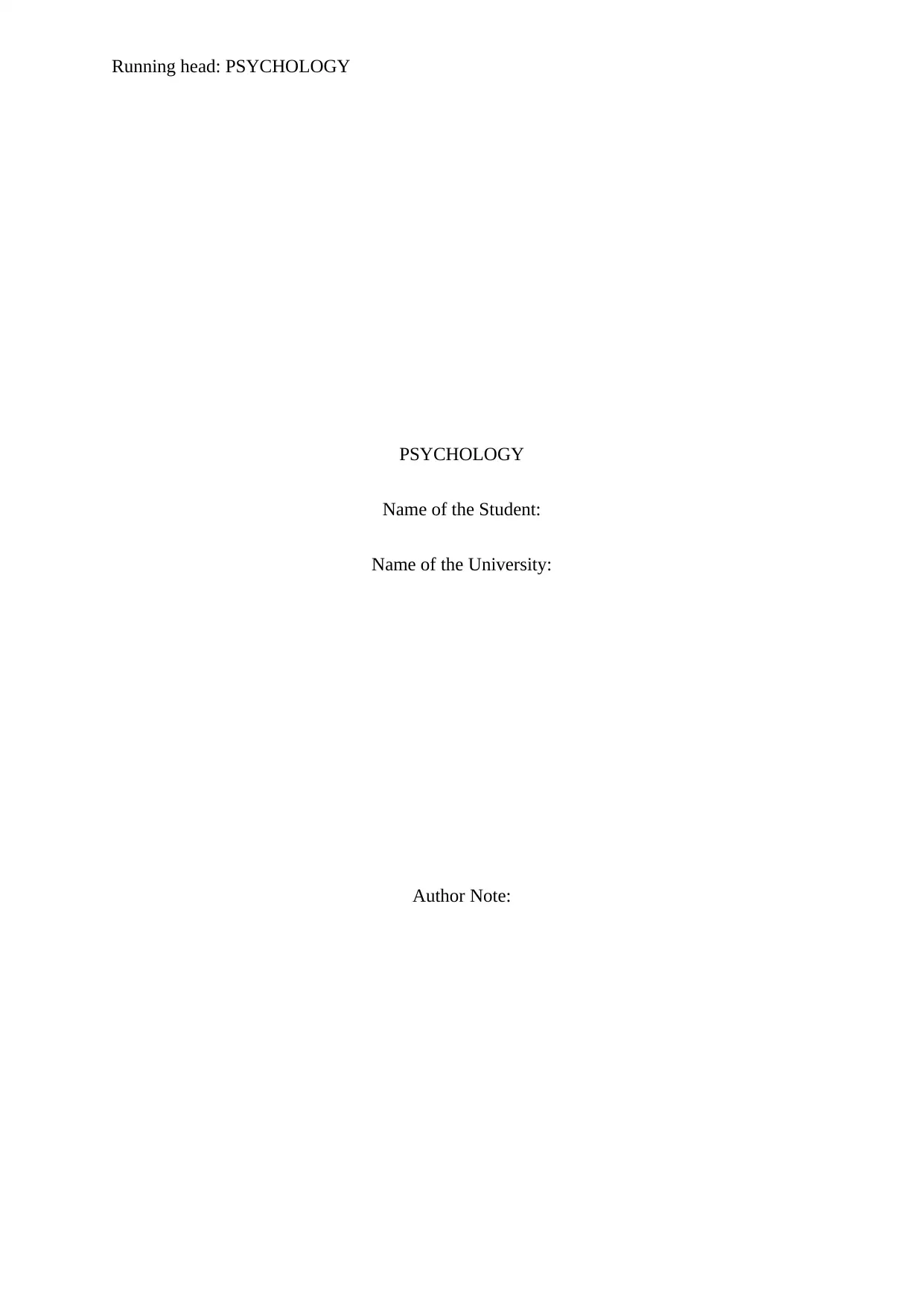
Running head: PSYCHOLOGY
PSYCHOLOGY
Name of the Student:
Name of the University:
Author Note:
PSYCHOLOGY
Name of the Student:
Name of the University:
Author Note:
Paraphrase This Document
Need a fresh take? Get an instant paraphrase of this document with our AI Paraphraser
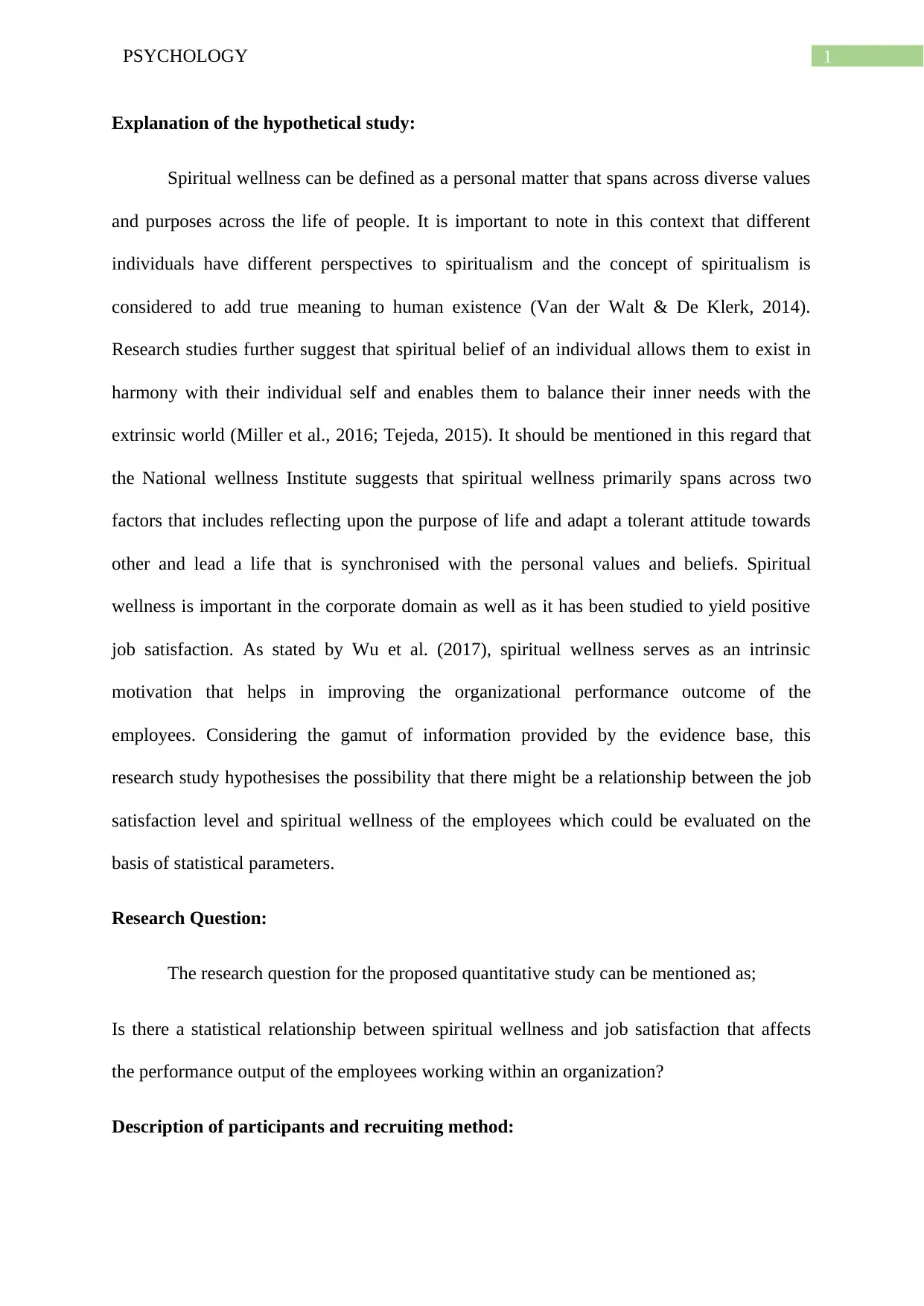
1PSYCHOLOGY
Explanation of the hypothetical study:
Spiritual wellness can be defined as a personal matter that spans across diverse values
and purposes across the life of people. It is important to note in this context that different
individuals have different perspectives to spiritualism and the concept of spiritualism is
considered to add true meaning to human existence (Van der Walt & De Klerk, 2014).
Research studies further suggest that spiritual belief of an individual allows them to exist in
harmony with their individual self and enables them to balance their inner needs with the
extrinsic world (Miller et al., 2016; Tejeda, 2015). It should be mentioned in this regard that
the National wellness Institute suggests that spiritual wellness primarily spans across two
factors that includes reflecting upon the purpose of life and adapt a tolerant attitude towards
other and lead a life that is synchronised with the personal values and beliefs. Spiritual
wellness is important in the corporate domain as well as it has been studied to yield positive
job satisfaction. As stated by Wu et al. (2017), spiritual wellness serves as an intrinsic
motivation that helps in improving the organizational performance outcome of the
employees. Considering the gamut of information provided by the evidence base, this
research study hypothesises the possibility that there might be a relationship between the job
satisfaction level and spiritual wellness of the employees which could be evaluated on the
basis of statistical parameters.
Research Question:
The research question for the proposed quantitative study can be mentioned as;
Is there a statistical relationship between spiritual wellness and job satisfaction that affects
the performance output of the employees working within an organization?
Description of participants and recruiting method:
Explanation of the hypothetical study:
Spiritual wellness can be defined as a personal matter that spans across diverse values
and purposes across the life of people. It is important to note in this context that different
individuals have different perspectives to spiritualism and the concept of spiritualism is
considered to add true meaning to human existence (Van der Walt & De Klerk, 2014).
Research studies further suggest that spiritual belief of an individual allows them to exist in
harmony with their individual self and enables them to balance their inner needs with the
extrinsic world (Miller et al., 2016; Tejeda, 2015). It should be mentioned in this regard that
the National wellness Institute suggests that spiritual wellness primarily spans across two
factors that includes reflecting upon the purpose of life and adapt a tolerant attitude towards
other and lead a life that is synchronised with the personal values and beliefs. Spiritual
wellness is important in the corporate domain as well as it has been studied to yield positive
job satisfaction. As stated by Wu et al. (2017), spiritual wellness serves as an intrinsic
motivation that helps in improving the organizational performance outcome of the
employees. Considering the gamut of information provided by the evidence base, this
research study hypothesises the possibility that there might be a relationship between the job
satisfaction level and spiritual wellness of the employees which could be evaluated on the
basis of statistical parameters.
Research Question:
The research question for the proposed quantitative study can be mentioned as;
Is there a statistical relationship between spiritual wellness and job satisfaction that affects
the performance output of the employees working within an organization?
Description of participants and recruiting method:
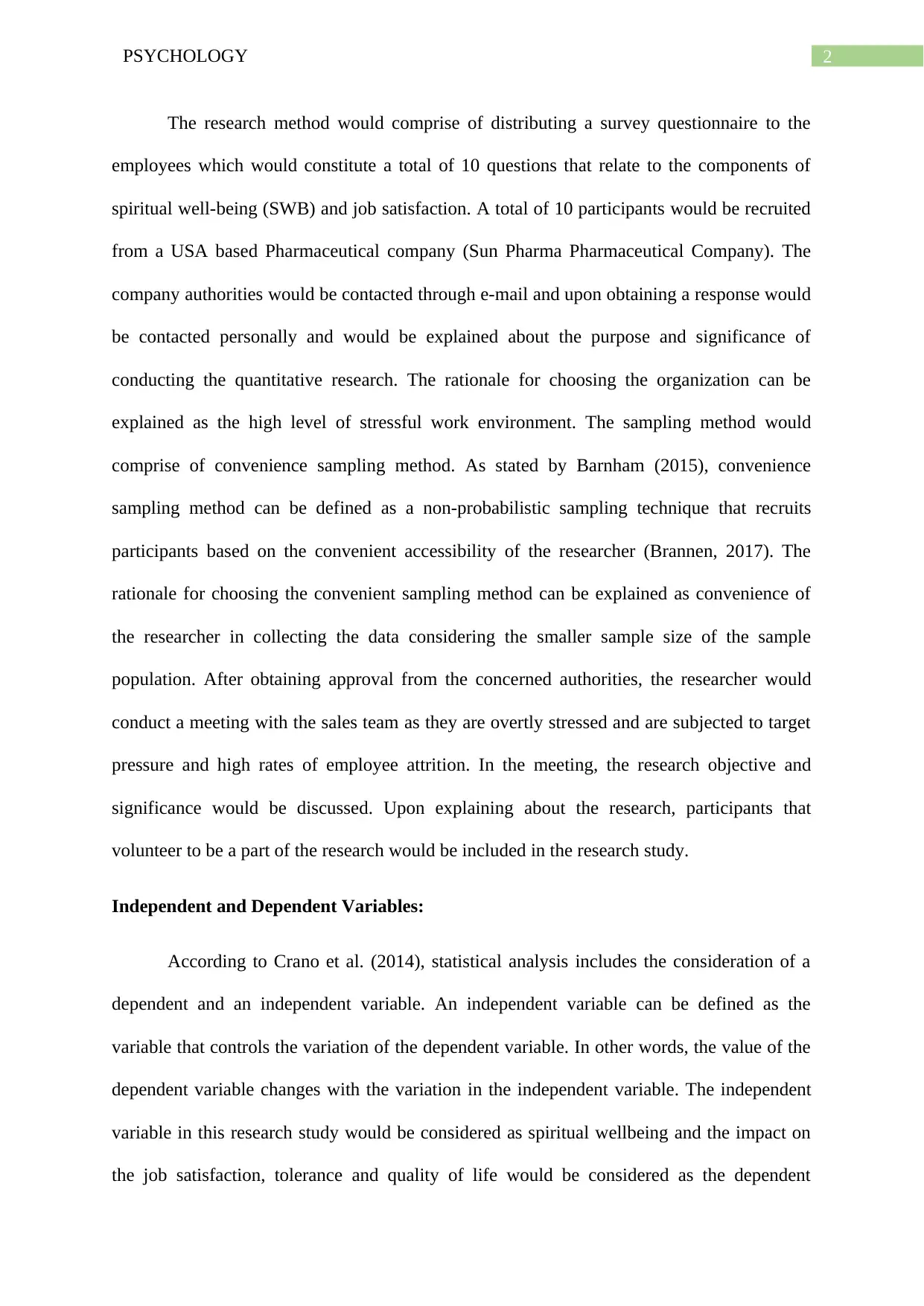
2PSYCHOLOGY
The research method would comprise of distributing a survey questionnaire to the
employees which would constitute a total of 10 questions that relate to the components of
spiritual well-being (SWB) and job satisfaction. A total of 10 participants would be recruited
from a USA based Pharmaceutical company (Sun Pharma Pharmaceutical Company). The
company authorities would be contacted through e-mail and upon obtaining a response would
be contacted personally and would be explained about the purpose and significance of
conducting the quantitative research. The rationale for choosing the organization can be
explained as the high level of stressful work environment. The sampling method would
comprise of convenience sampling method. As stated by Barnham (2015), convenience
sampling method can be defined as a non-probabilistic sampling technique that recruits
participants based on the convenient accessibility of the researcher (Brannen, 2017). The
rationale for choosing the convenient sampling method can be explained as convenience of
the researcher in collecting the data considering the smaller sample size of the sample
population. After obtaining approval from the concerned authorities, the researcher would
conduct a meeting with the sales team as they are overtly stressed and are subjected to target
pressure and high rates of employee attrition. In the meeting, the research objective and
significance would be discussed. Upon explaining about the research, participants that
volunteer to be a part of the research would be included in the research study.
Independent and Dependent Variables:
According to Crano et al. (2014), statistical analysis includes the consideration of a
dependent and an independent variable. An independent variable can be defined as the
variable that controls the variation of the dependent variable. In other words, the value of the
dependent variable changes with the variation in the independent variable. The independent
variable in this research study would be considered as spiritual wellbeing and the impact on
the job satisfaction, tolerance and quality of life would be considered as the dependent
The research method would comprise of distributing a survey questionnaire to the
employees which would constitute a total of 10 questions that relate to the components of
spiritual well-being (SWB) and job satisfaction. A total of 10 participants would be recruited
from a USA based Pharmaceutical company (Sun Pharma Pharmaceutical Company). The
company authorities would be contacted through e-mail and upon obtaining a response would
be contacted personally and would be explained about the purpose and significance of
conducting the quantitative research. The rationale for choosing the organization can be
explained as the high level of stressful work environment. The sampling method would
comprise of convenience sampling method. As stated by Barnham (2015), convenience
sampling method can be defined as a non-probabilistic sampling technique that recruits
participants based on the convenient accessibility of the researcher (Brannen, 2017). The
rationale for choosing the convenient sampling method can be explained as convenience of
the researcher in collecting the data considering the smaller sample size of the sample
population. After obtaining approval from the concerned authorities, the researcher would
conduct a meeting with the sales team as they are overtly stressed and are subjected to target
pressure and high rates of employee attrition. In the meeting, the research objective and
significance would be discussed. Upon explaining about the research, participants that
volunteer to be a part of the research would be included in the research study.
Independent and Dependent Variables:
According to Crano et al. (2014), statistical analysis includes the consideration of a
dependent and an independent variable. An independent variable can be defined as the
variable that controls the variation of the dependent variable. In other words, the value of the
dependent variable changes with the variation in the independent variable. The independent
variable in this research study would be considered as spiritual wellbeing and the impact on
the job satisfaction, tolerance and quality of life would be considered as the dependent
⊘ This is a preview!⊘
Do you want full access?
Subscribe today to unlock all pages.

Trusted by 1+ million students worldwide

3PSYCHOLOGY
variable. The independent variable of spiritual wellness would be measured on the parameters
of job satisfaction level.
Reliability and Validity of the study:
As stated by Barnham (2015), reliability defines the consistency of a measurement.
Psychologists generally rely upon three types of consistency that comprises of over test or
test-retest reliability, across items or internal consistency and across different researchers or
inter-rater reliability. In this research, the researcher would consider the internal consistency
which evaluated the consistency of the people’s response with respect to different items on a
multiple-item measure. The basic underlying principle is that all items based on the
considered measures would relate to the same construct such that cumulative score of the
people would correlate with one another, otherwise the claim would not make sense and
evaluate the same underlying construct. This holds true for behavioural measures,
psychological measures as well as self-report measures. Internal consistency can be assessed
by collecting and analysing data. Researchers generally adapt a split-half correction method
in order to analyse the collected data. The approach includes splitting the items into 2 data
sets in a manner that the first and second halves of the items are divided into even and odd
numbered items. A score is then calculated for each of the items and after that the two sets of
scores are examined. Validity can be defined as the extent to which the scores appropriately
measure the variables. In order to determine the validity of a research study, researchers often
rely upon test-retest reliability and internal consistency (Crano et al., 2014). This enables the
researcher to confidently explain what the scores represent. In this case, the researchers
would rely upon criterion validity in order to estimate that people’s scores on a measure are
correlated with other criteria or variables that are assumed to be correlated. In this case,
spiritual wellbeing is expected to improve the job performance of the employees and on
evaluation of the response if the scores reflect that spiritual wellness leads to performance
variable. The independent variable of spiritual wellness would be measured on the parameters
of job satisfaction level.
Reliability and Validity of the study:
As stated by Barnham (2015), reliability defines the consistency of a measurement.
Psychologists generally rely upon three types of consistency that comprises of over test or
test-retest reliability, across items or internal consistency and across different researchers or
inter-rater reliability. In this research, the researcher would consider the internal consistency
which evaluated the consistency of the people’s response with respect to different items on a
multiple-item measure. The basic underlying principle is that all items based on the
considered measures would relate to the same construct such that cumulative score of the
people would correlate with one another, otherwise the claim would not make sense and
evaluate the same underlying construct. This holds true for behavioural measures,
psychological measures as well as self-report measures. Internal consistency can be assessed
by collecting and analysing data. Researchers generally adapt a split-half correction method
in order to analyse the collected data. The approach includes splitting the items into 2 data
sets in a manner that the first and second halves of the items are divided into even and odd
numbered items. A score is then calculated for each of the items and after that the two sets of
scores are examined. Validity can be defined as the extent to which the scores appropriately
measure the variables. In order to determine the validity of a research study, researchers often
rely upon test-retest reliability and internal consistency (Crano et al., 2014). This enables the
researcher to confidently explain what the scores represent. In this case, the researchers
would rely upon criterion validity in order to estimate that people’s scores on a measure are
correlated with other criteria or variables that are assumed to be correlated. In this case,
spiritual wellbeing is expected to improve the job performance of the employees and on
evaluation of the response if the scores reflect that spiritual wellness leads to performance
Paraphrase This Document
Need a fresh take? Get an instant paraphrase of this document with our AI Paraphraser
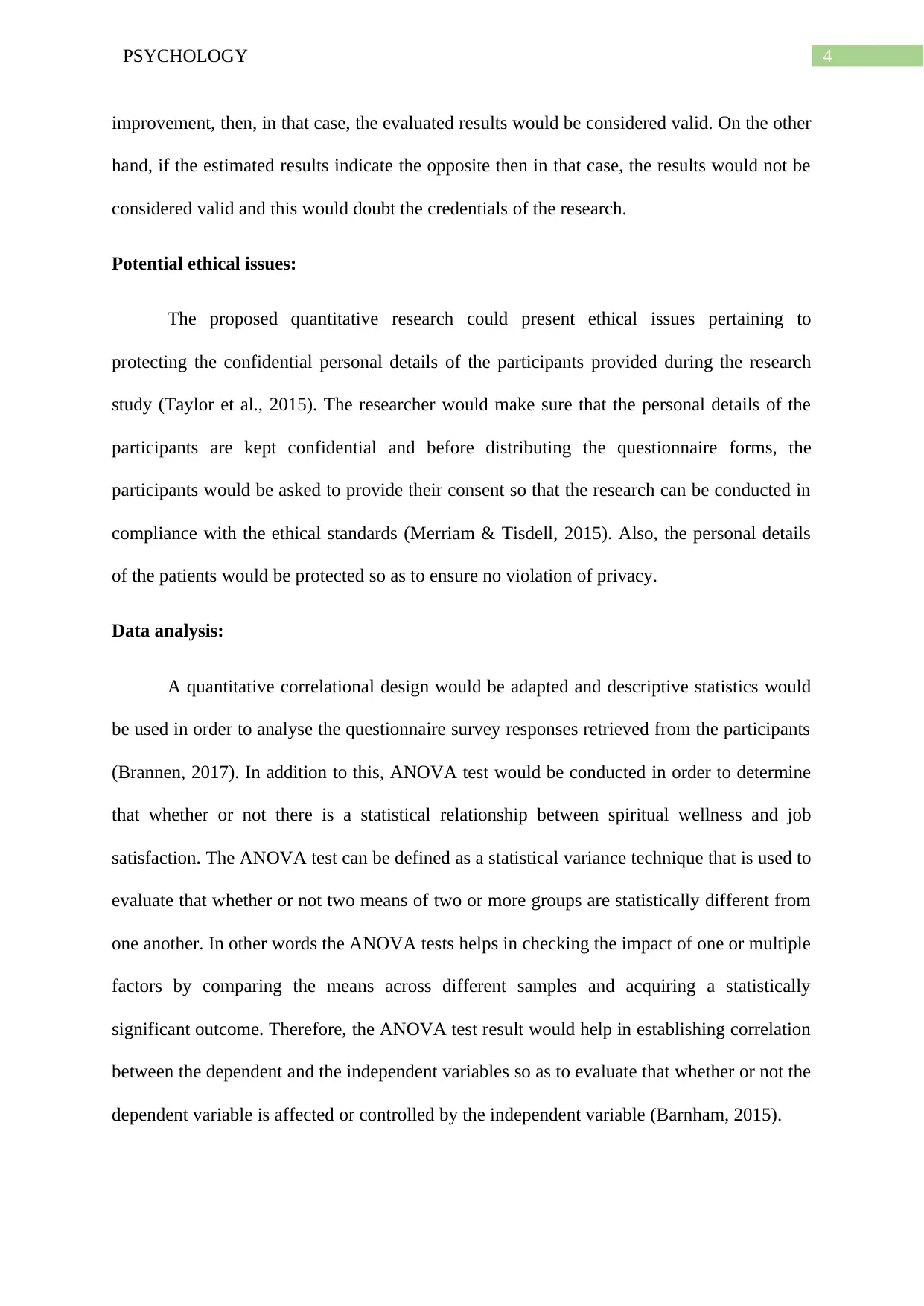
4PSYCHOLOGY
improvement, then, in that case, the evaluated results would be considered valid. On the other
hand, if the estimated results indicate the opposite then in that case, the results would not be
considered valid and this would doubt the credentials of the research.
Potential ethical issues:
The proposed quantitative research could present ethical issues pertaining to
protecting the confidential personal details of the participants provided during the research
study (Taylor et al., 2015). The researcher would make sure that the personal details of the
participants are kept confidential and before distributing the questionnaire forms, the
participants would be asked to provide their consent so that the research can be conducted in
compliance with the ethical standards (Merriam & Tisdell, 2015). Also, the personal details
of the patients would be protected so as to ensure no violation of privacy.
Data analysis:
A quantitative correlational design would be adapted and descriptive statistics would
be used in order to analyse the questionnaire survey responses retrieved from the participants
(Brannen, 2017). In addition to this, ANOVA test would be conducted in order to determine
that whether or not there is a statistical relationship between spiritual wellness and job
satisfaction. The ANOVA test can be defined as a statistical variance technique that is used to
evaluate that whether or not two means of two or more groups are statistically different from
one another. In other words the ANOVA tests helps in checking the impact of one or multiple
factors by comparing the means across different samples and acquiring a statistically
significant outcome. Therefore, the ANOVA test result would help in establishing correlation
between the dependent and the independent variables so as to evaluate that whether or not the
dependent variable is affected or controlled by the independent variable (Barnham, 2015).
improvement, then, in that case, the evaluated results would be considered valid. On the other
hand, if the estimated results indicate the opposite then in that case, the results would not be
considered valid and this would doubt the credentials of the research.
Potential ethical issues:
The proposed quantitative research could present ethical issues pertaining to
protecting the confidential personal details of the participants provided during the research
study (Taylor et al., 2015). The researcher would make sure that the personal details of the
participants are kept confidential and before distributing the questionnaire forms, the
participants would be asked to provide their consent so that the research can be conducted in
compliance with the ethical standards (Merriam & Tisdell, 2015). Also, the personal details
of the patients would be protected so as to ensure no violation of privacy.
Data analysis:
A quantitative correlational design would be adapted and descriptive statistics would
be used in order to analyse the questionnaire survey responses retrieved from the participants
(Brannen, 2017). In addition to this, ANOVA test would be conducted in order to determine
that whether or not there is a statistical relationship between spiritual wellness and job
satisfaction. The ANOVA test can be defined as a statistical variance technique that is used to
evaluate that whether or not two means of two or more groups are statistically different from
one another. In other words the ANOVA tests helps in checking the impact of one or multiple
factors by comparing the means across different samples and acquiring a statistically
significant outcome. Therefore, the ANOVA test result would help in establishing correlation
between the dependent and the independent variables so as to evaluate that whether or not the
dependent variable is affected or controlled by the independent variable (Barnham, 2015).
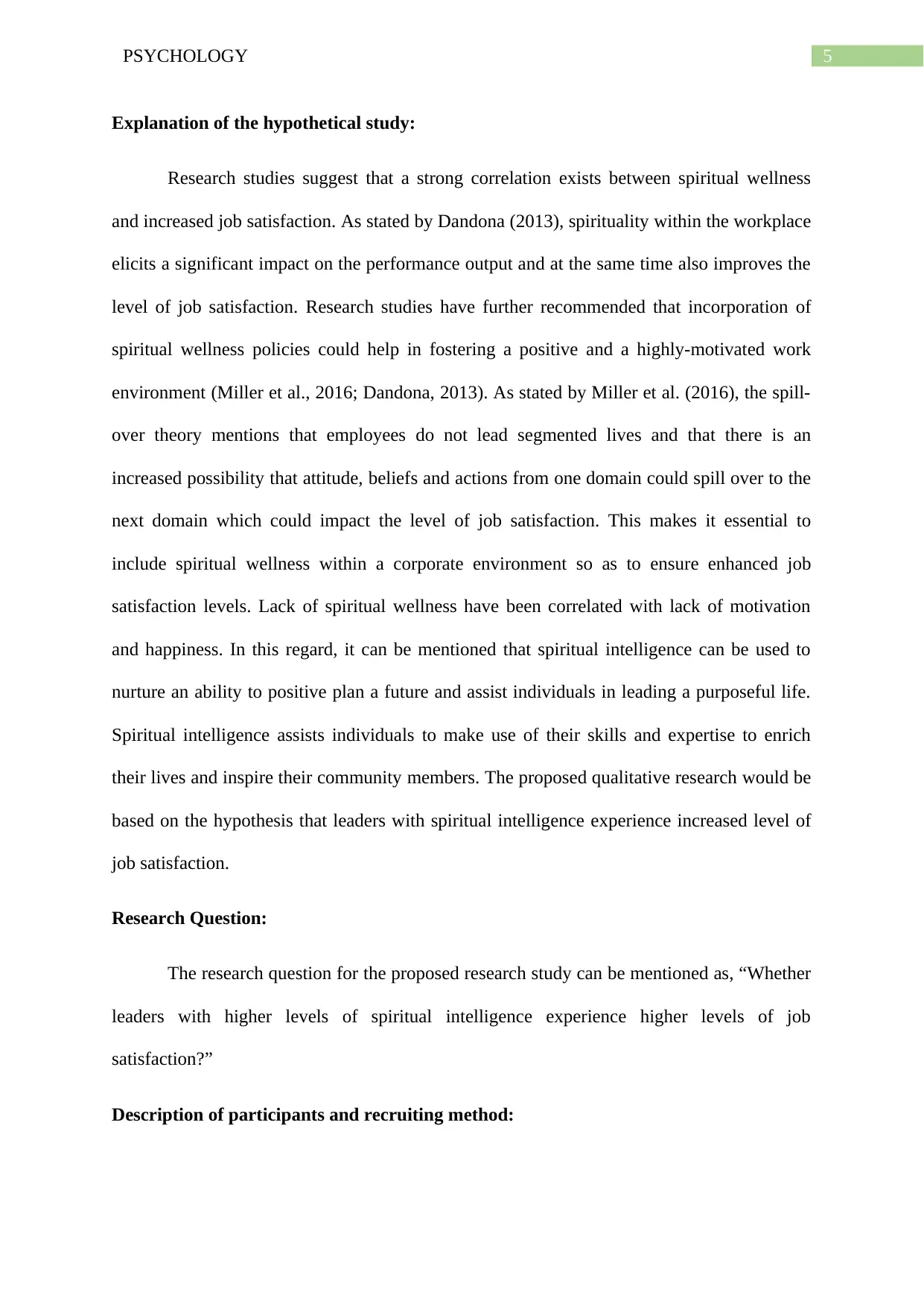
5PSYCHOLOGY
Explanation of the hypothetical study:
Research studies suggest that a strong correlation exists between spiritual wellness
and increased job satisfaction. As stated by Dandona (2013), spirituality within the workplace
elicits a significant impact on the performance output and at the same time also improves the
level of job satisfaction. Research studies have further recommended that incorporation of
spiritual wellness policies could help in fostering a positive and a highly-motivated work
environment (Miller et al., 2016; Dandona, 2013). As stated by Miller et al. (2016), the spill-
over theory mentions that employees do not lead segmented lives and that there is an
increased possibility that attitude, beliefs and actions from one domain could spill over to the
next domain which could impact the level of job satisfaction. This makes it essential to
include spiritual wellness within a corporate environment so as to ensure enhanced job
satisfaction levels. Lack of spiritual wellness have been correlated with lack of motivation
and happiness. In this regard, it can be mentioned that spiritual intelligence can be used to
nurture an ability to positive plan a future and assist individuals in leading a purposeful life.
Spiritual intelligence assists individuals to make use of their skills and expertise to enrich
their lives and inspire their community members. The proposed qualitative research would be
based on the hypothesis that leaders with spiritual intelligence experience increased level of
job satisfaction.
Research Question:
The research question for the proposed research study can be mentioned as, “Whether
leaders with higher levels of spiritual intelligence experience higher levels of job
satisfaction?”
Description of participants and recruiting method:
Explanation of the hypothetical study:
Research studies suggest that a strong correlation exists between spiritual wellness
and increased job satisfaction. As stated by Dandona (2013), spirituality within the workplace
elicits a significant impact on the performance output and at the same time also improves the
level of job satisfaction. Research studies have further recommended that incorporation of
spiritual wellness policies could help in fostering a positive and a highly-motivated work
environment (Miller et al., 2016; Dandona, 2013). As stated by Miller et al. (2016), the spill-
over theory mentions that employees do not lead segmented lives and that there is an
increased possibility that attitude, beliefs and actions from one domain could spill over to the
next domain which could impact the level of job satisfaction. This makes it essential to
include spiritual wellness within a corporate environment so as to ensure enhanced job
satisfaction levels. Lack of spiritual wellness have been correlated with lack of motivation
and happiness. In this regard, it can be mentioned that spiritual intelligence can be used to
nurture an ability to positive plan a future and assist individuals in leading a purposeful life.
Spiritual intelligence assists individuals to make use of their skills and expertise to enrich
their lives and inspire their community members. The proposed qualitative research would be
based on the hypothesis that leaders with spiritual intelligence experience increased level of
job satisfaction.
Research Question:
The research question for the proposed research study can be mentioned as, “Whether
leaders with higher levels of spiritual intelligence experience higher levels of job
satisfaction?”
Description of participants and recruiting method:
⊘ This is a preview!⊘
Do you want full access?
Subscribe today to unlock all pages.

Trusted by 1+ million students worldwide
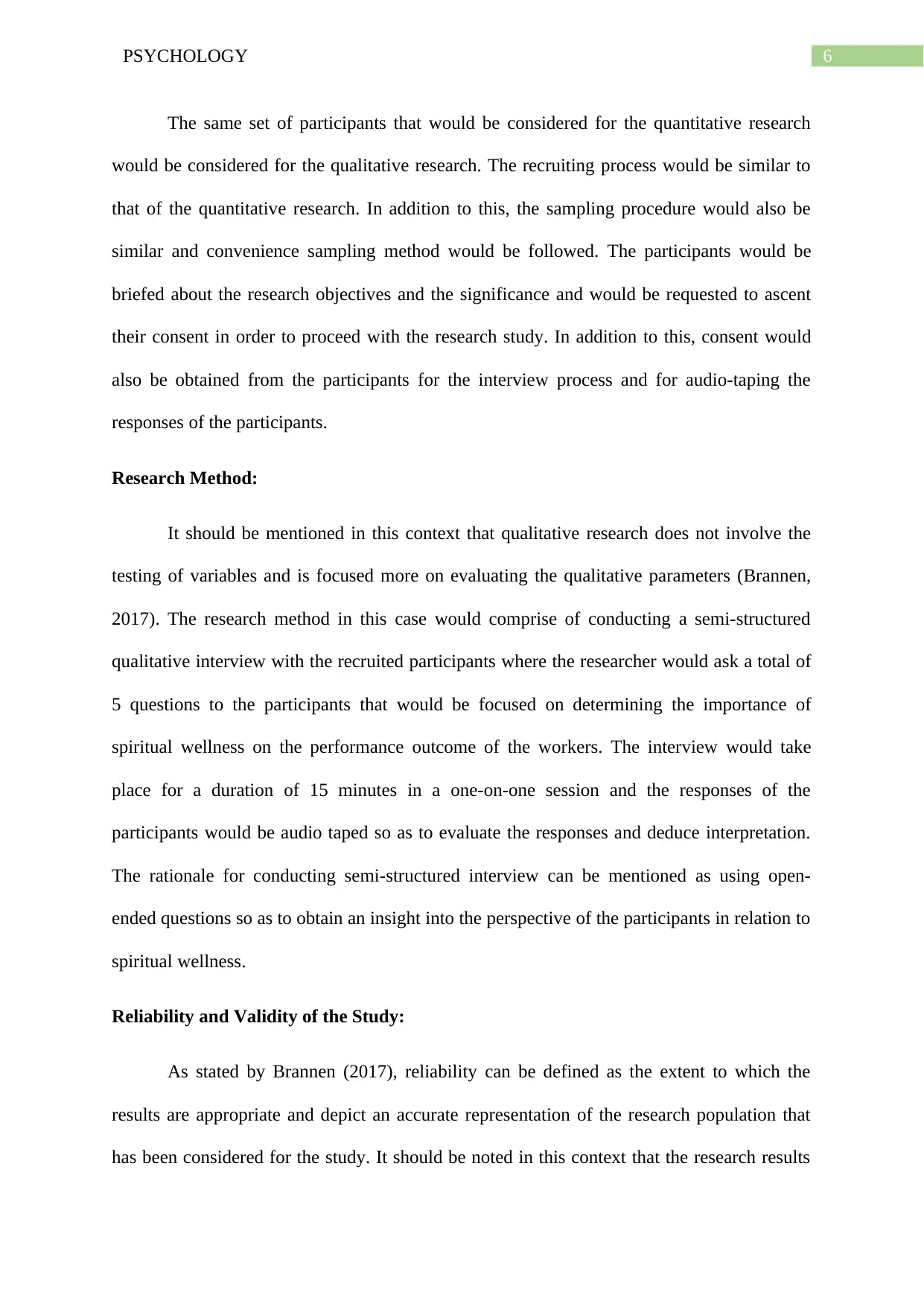
6PSYCHOLOGY
The same set of participants that would be considered for the quantitative research
would be considered for the qualitative research. The recruiting process would be similar to
that of the quantitative research. In addition to this, the sampling procedure would also be
similar and convenience sampling method would be followed. The participants would be
briefed about the research objectives and the significance and would be requested to ascent
their consent in order to proceed with the research study. In addition to this, consent would
also be obtained from the participants for the interview process and for audio-taping the
responses of the participants.
Research Method:
It should be mentioned in this context that qualitative research does not involve the
testing of variables and is focused more on evaluating the qualitative parameters (Brannen,
2017). The research method in this case would comprise of conducting a semi-structured
qualitative interview with the recruited participants where the researcher would ask a total of
5 questions to the participants that would be focused on determining the importance of
spiritual wellness on the performance outcome of the workers. The interview would take
place for a duration of 15 minutes in a one-on-one session and the responses of the
participants would be audio taped so as to evaluate the responses and deduce interpretation.
The rationale for conducting semi-structured interview can be mentioned as using open-
ended questions so as to obtain an insight into the perspective of the participants in relation to
spiritual wellness.
Reliability and Validity of the Study:
As stated by Brannen (2017), reliability can be defined as the extent to which the
results are appropriate and depict an accurate representation of the research population that
has been considered for the study. It should be noted in this context that the research results
The same set of participants that would be considered for the quantitative research
would be considered for the qualitative research. The recruiting process would be similar to
that of the quantitative research. In addition to this, the sampling procedure would also be
similar and convenience sampling method would be followed. The participants would be
briefed about the research objectives and the significance and would be requested to ascent
their consent in order to proceed with the research study. In addition to this, consent would
also be obtained from the participants for the interview process and for audio-taping the
responses of the participants.
Research Method:
It should be mentioned in this context that qualitative research does not involve the
testing of variables and is focused more on evaluating the qualitative parameters (Brannen,
2017). The research method in this case would comprise of conducting a semi-structured
qualitative interview with the recruited participants where the researcher would ask a total of
5 questions to the participants that would be focused on determining the importance of
spiritual wellness on the performance outcome of the workers. The interview would take
place for a duration of 15 minutes in a one-on-one session and the responses of the
participants would be audio taped so as to evaluate the responses and deduce interpretation.
The rationale for conducting semi-structured interview can be mentioned as using open-
ended questions so as to obtain an insight into the perspective of the participants in relation to
spiritual wellness.
Reliability and Validity of the Study:
As stated by Brannen (2017), reliability can be defined as the extent to which the
results are appropriate and depict an accurate representation of the research population that
has been considered for the study. It should be noted in this context that the research results
Paraphrase This Document
Need a fresh take? Get an instant paraphrase of this document with our AI Paraphraser

7PSYCHOLOGY
are considered appropriate only if the results can be reproduced using a similar methodology
and in that case the research instrument that has been used is considered reliable. In this case
the reliability of the research would be evaluated on the extent to which the results values are
repeated. The extent to which the values are repeated help in determining the internal
consistency. On the other hand, the validity of the research would be determined on the basis
of the positivism theory of validity. In this case, the validity of the research would be
evaluated in terms of positive testing of the hypothesis through the collected data and the
related interpretation. In addition to this, the analysed data would be compared and contrasted
with the evidence base so as to identify common themes which would help in validating the
obtained results.
Potential Ethical Issues:
According to Crano et al. (2014), conducting a social research includes the
consideration of a number of ethical issues. Ethical issues majorly cover a tension between
the objectives of the research in order to generalize the findings so as to protect the privacy of
the participants. Ethics is concerned with doing no harm to the participants and abiding by the
ethical principles of a social research. In this case, the ethical issues might include, violation
of participant’s confidentiality or privacy (Silverman, 2016). This is on account of the reason
that the response of the participants would be audio-taped and evaluated for the process of
data analysis. In order to effectively address the ethical concern, consent would be obtained
from the participants before conducting the interview process (Brannen, 2017; Merriam &
Tisdell, 2015). In addition to this, consent would also be obtained from the participants to
audiotape their responses and use their responses for the process of data analysis. This would
help in protecting the privacy and confidentiality of the participants so as to ensure that the
ethics standards of the research are not compromised.
are considered appropriate only if the results can be reproduced using a similar methodology
and in that case the research instrument that has been used is considered reliable. In this case
the reliability of the research would be evaluated on the extent to which the results values are
repeated. The extent to which the values are repeated help in determining the internal
consistency. On the other hand, the validity of the research would be determined on the basis
of the positivism theory of validity. In this case, the validity of the research would be
evaluated in terms of positive testing of the hypothesis through the collected data and the
related interpretation. In addition to this, the analysed data would be compared and contrasted
with the evidence base so as to identify common themes which would help in validating the
obtained results.
Potential Ethical Issues:
According to Crano et al. (2014), conducting a social research includes the
consideration of a number of ethical issues. Ethical issues majorly cover a tension between
the objectives of the research in order to generalize the findings so as to protect the privacy of
the participants. Ethics is concerned with doing no harm to the participants and abiding by the
ethical principles of a social research. In this case, the ethical issues might include, violation
of participant’s confidentiality or privacy (Silverman, 2016). This is on account of the reason
that the response of the participants would be audio-taped and evaluated for the process of
data analysis. In order to effectively address the ethical concern, consent would be obtained
from the participants before conducting the interview process (Brannen, 2017; Merriam &
Tisdell, 2015). In addition to this, consent would also be obtained from the participants to
audiotape their responses and use their responses for the process of data analysis. This would
help in protecting the privacy and confidentiality of the participants so as to ensure that the
ethics standards of the research are not compromised.
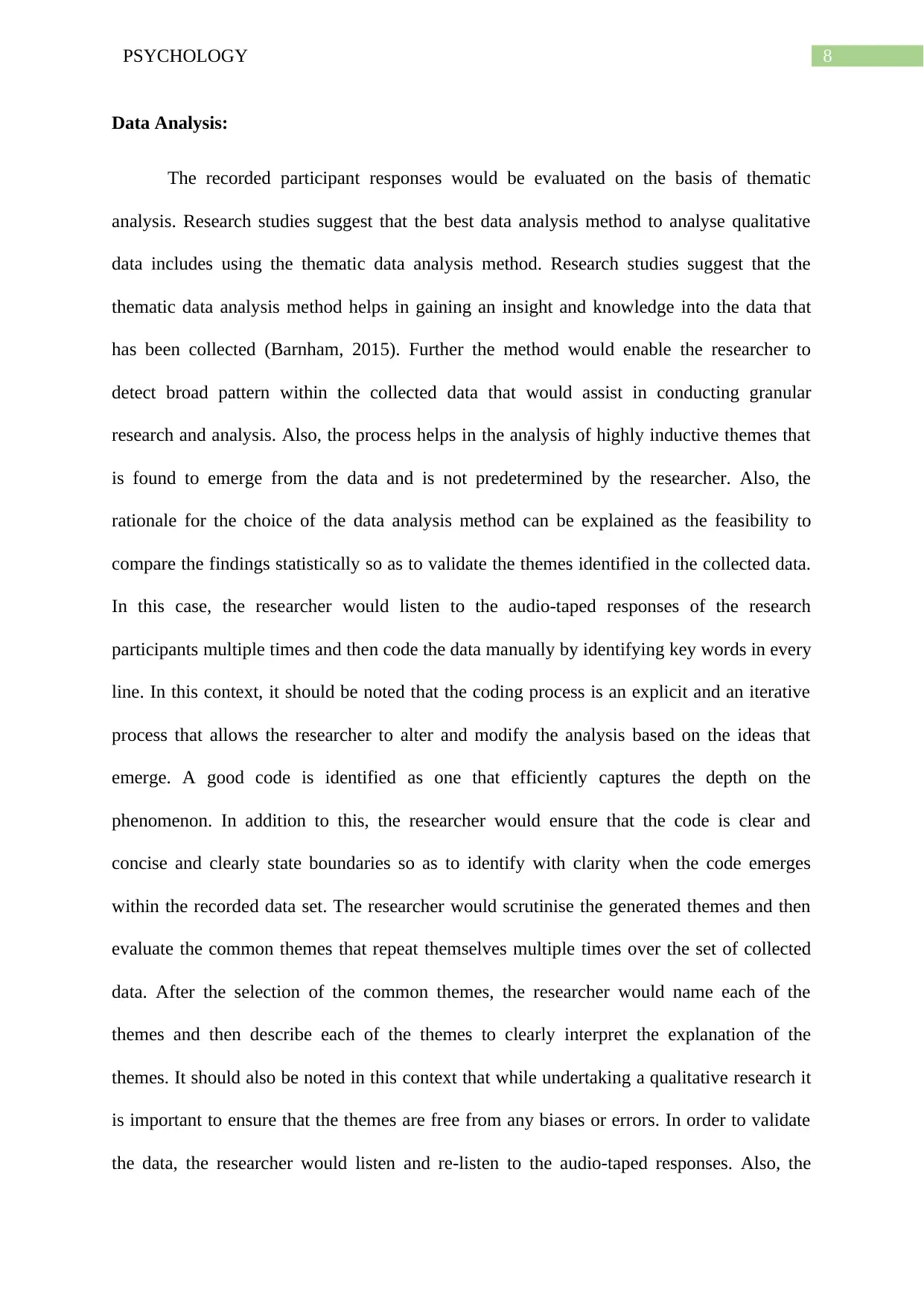
8PSYCHOLOGY
Data Analysis:
The recorded participant responses would be evaluated on the basis of thematic
analysis. Research studies suggest that the best data analysis method to analyse qualitative
data includes using the thematic data analysis method. Research studies suggest that the
thematic data analysis method helps in gaining an insight and knowledge into the data that
has been collected (Barnham, 2015). Further the method would enable the researcher to
detect broad pattern within the collected data that would assist in conducting granular
research and analysis. Also, the process helps in the analysis of highly inductive themes that
is found to emerge from the data and is not predetermined by the researcher. Also, the
rationale for the choice of the data analysis method can be explained as the feasibility to
compare the findings statistically so as to validate the themes identified in the collected data.
In this case, the researcher would listen to the audio-taped responses of the research
participants multiple times and then code the data manually by identifying key words in every
line. In this context, it should be noted that the coding process is an explicit and an iterative
process that allows the researcher to alter and modify the analysis based on the ideas that
emerge. A good code is identified as one that efficiently captures the depth on the
phenomenon. In addition to this, the researcher would ensure that the code is clear and
concise and clearly state boundaries so as to identify with clarity when the code emerges
within the recorded data set. The researcher would scrutinise the generated themes and then
evaluate the common themes that repeat themselves multiple times over the set of collected
data. After the selection of the common themes, the researcher would name each of the
themes and then describe each of the themes to clearly interpret the explanation of the
themes. It should also be noted in this context that while undertaking a qualitative research it
is important to ensure that the themes are free from any biases or errors. In order to validate
the data, the researcher would listen and re-listen to the audio-taped responses. Also, the
Data Analysis:
The recorded participant responses would be evaluated on the basis of thematic
analysis. Research studies suggest that the best data analysis method to analyse qualitative
data includes using the thematic data analysis method. Research studies suggest that the
thematic data analysis method helps in gaining an insight and knowledge into the data that
has been collected (Barnham, 2015). Further the method would enable the researcher to
detect broad pattern within the collected data that would assist in conducting granular
research and analysis. Also, the process helps in the analysis of highly inductive themes that
is found to emerge from the data and is not predetermined by the researcher. Also, the
rationale for the choice of the data analysis method can be explained as the feasibility to
compare the findings statistically so as to validate the themes identified in the collected data.
In this case, the researcher would listen to the audio-taped responses of the research
participants multiple times and then code the data manually by identifying key words in every
line. In this context, it should be noted that the coding process is an explicit and an iterative
process that allows the researcher to alter and modify the analysis based on the ideas that
emerge. A good code is identified as one that efficiently captures the depth on the
phenomenon. In addition to this, the researcher would ensure that the code is clear and
concise and clearly state boundaries so as to identify with clarity when the code emerges
within the recorded data set. The researcher would scrutinise the generated themes and then
evaluate the common themes that repeat themselves multiple times over the set of collected
data. After the selection of the common themes, the researcher would name each of the
themes and then describe each of the themes to clearly interpret the explanation of the
themes. It should also be noted in this context that while undertaking a qualitative research it
is important to ensure that the themes are free from any biases or errors. In order to validate
the data, the researcher would listen and re-listen to the audio-taped responses. Also, the
⊘ This is a preview!⊘
Do you want full access?
Subscribe today to unlock all pages.

Trusted by 1+ million students worldwide
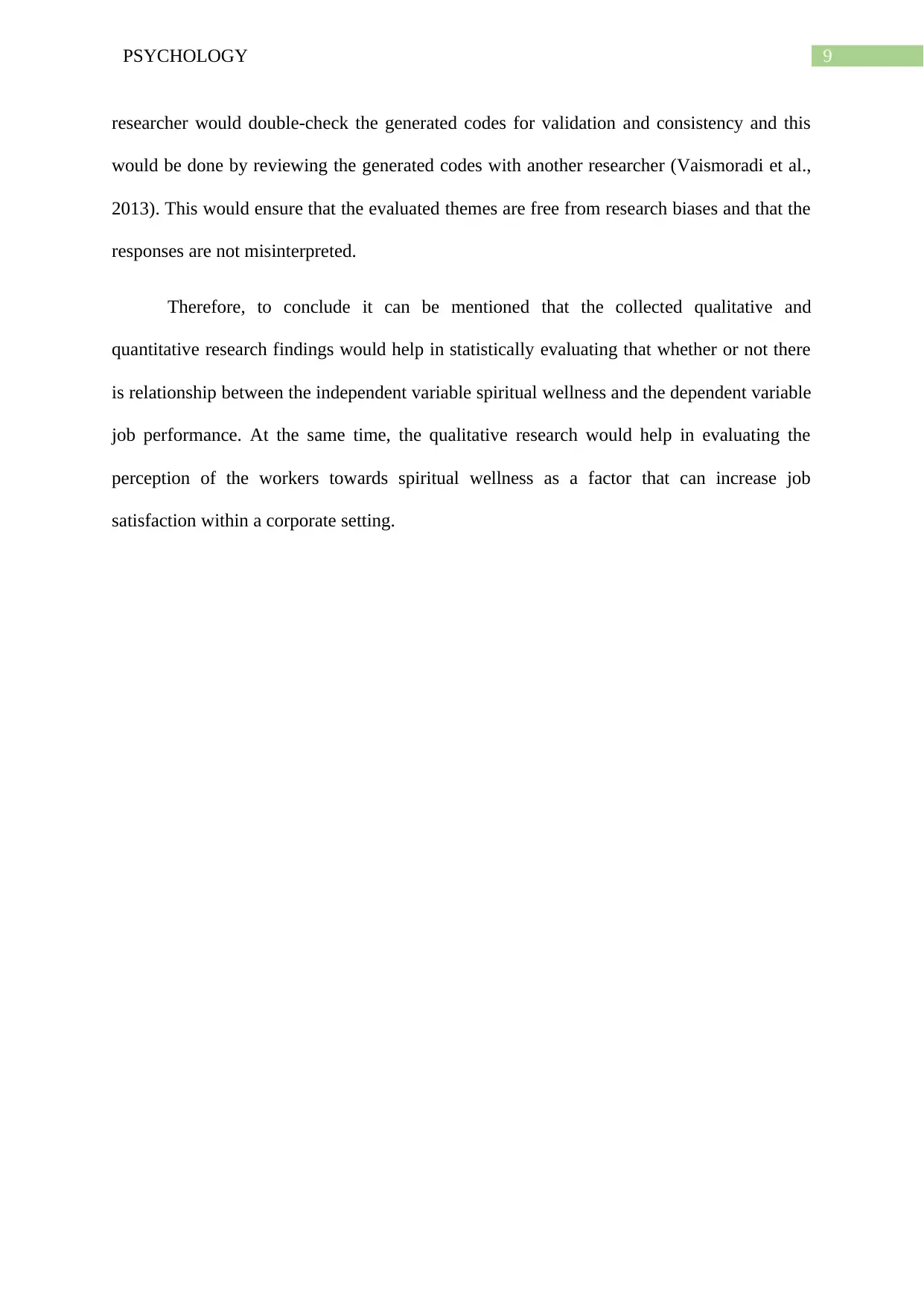
9PSYCHOLOGY
researcher would double-check the generated codes for validation and consistency and this
would be done by reviewing the generated codes with another researcher (Vaismoradi et al.,
2013). This would ensure that the evaluated themes are free from research biases and that the
responses are not misinterpreted.
Therefore, to conclude it can be mentioned that the collected qualitative and
quantitative research findings would help in statistically evaluating that whether or not there
is relationship between the independent variable spiritual wellness and the dependent variable
job performance. At the same time, the qualitative research would help in evaluating the
perception of the workers towards spiritual wellness as a factor that can increase job
satisfaction within a corporate setting.
researcher would double-check the generated codes for validation and consistency and this
would be done by reviewing the generated codes with another researcher (Vaismoradi et al.,
2013). This would ensure that the evaluated themes are free from research biases and that the
responses are not misinterpreted.
Therefore, to conclude it can be mentioned that the collected qualitative and
quantitative research findings would help in statistically evaluating that whether or not there
is relationship between the independent variable spiritual wellness and the dependent variable
job performance. At the same time, the qualitative research would help in evaluating the
perception of the workers towards spiritual wellness as a factor that can increase job
satisfaction within a corporate setting.
Paraphrase This Document
Need a fresh take? Get an instant paraphrase of this document with our AI Paraphraser
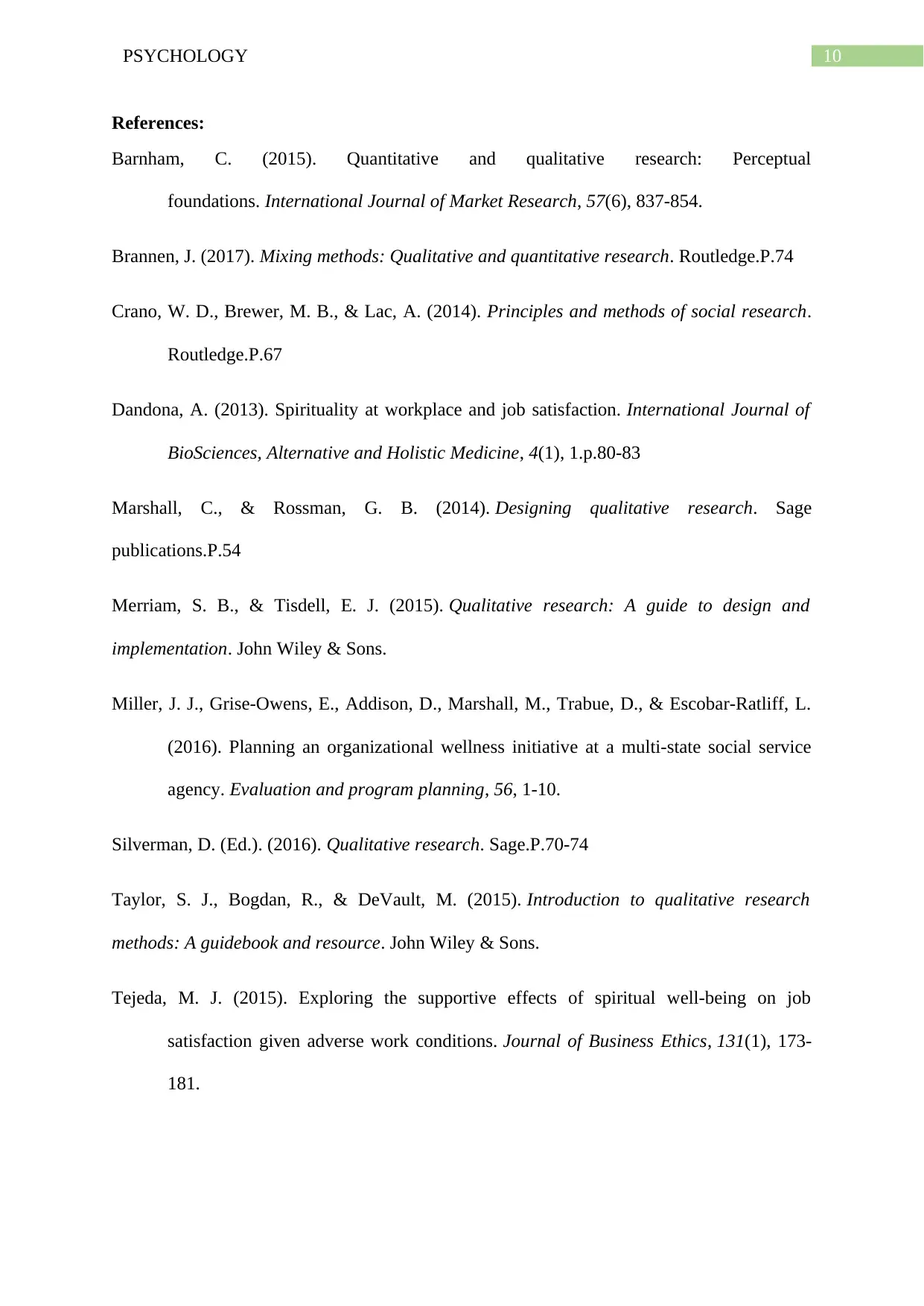
10PSYCHOLOGY
References:
Barnham, C. (2015). Quantitative and qualitative research: Perceptual
foundations. International Journal of Market Research, 57(6), 837-854.
Brannen, J. (2017). Mixing methods: Qualitative and quantitative research. Routledge.P.74
Crano, W. D., Brewer, M. B., & Lac, A. (2014). Principles and methods of social research.
Routledge.P.67
Dandona, A. (2013). Spirituality at workplace and job satisfaction. International Journal of
BioSciences, Alternative and Holistic Medicine, 4(1), 1.p.80-83
Marshall, C., & Rossman, G. B. (2014). Designing qualitative research. Sage
publications.P.54
Merriam, S. B., & Tisdell, E. J. (2015). Qualitative research: A guide to design and
implementation. John Wiley & Sons.
Miller, J. J., Grise-Owens, E., Addison, D., Marshall, M., Trabue, D., & Escobar-Ratliff, L.
(2016). Planning an organizational wellness initiative at a multi-state social service
agency. Evaluation and program planning, 56, 1-10.
Silverman, D. (Ed.). (2016). Qualitative research. Sage.P.70-74
Taylor, S. J., Bogdan, R., & DeVault, M. (2015). Introduction to qualitative research
methods: A guidebook and resource. John Wiley & Sons.
Tejeda, M. J. (2015). Exploring the supportive effects of spiritual well-being on job
satisfaction given adverse work conditions. Journal of Business Ethics, 131(1), 173-
181.
References:
Barnham, C. (2015). Quantitative and qualitative research: Perceptual
foundations. International Journal of Market Research, 57(6), 837-854.
Brannen, J. (2017). Mixing methods: Qualitative and quantitative research. Routledge.P.74
Crano, W. D., Brewer, M. B., & Lac, A. (2014). Principles and methods of social research.
Routledge.P.67
Dandona, A. (2013). Spirituality at workplace and job satisfaction. International Journal of
BioSciences, Alternative and Holistic Medicine, 4(1), 1.p.80-83
Marshall, C., & Rossman, G. B. (2014). Designing qualitative research. Sage
publications.P.54
Merriam, S. B., & Tisdell, E. J. (2015). Qualitative research: A guide to design and
implementation. John Wiley & Sons.
Miller, J. J., Grise-Owens, E., Addison, D., Marshall, M., Trabue, D., & Escobar-Ratliff, L.
(2016). Planning an organizational wellness initiative at a multi-state social service
agency. Evaluation and program planning, 56, 1-10.
Silverman, D. (Ed.). (2016). Qualitative research. Sage.P.70-74
Taylor, S. J., Bogdan, R., & DeVault, M. (2015). Introduction to qualitative research
methods: A guidebook and resource. John Wiley & Sons.
Tejeda, M. J. (2015). Exploring the supportive effects of spiritual well-being on job
satisfaction given adverse work conditions. Journal of Business Ethics, 131(1), 173-
181.
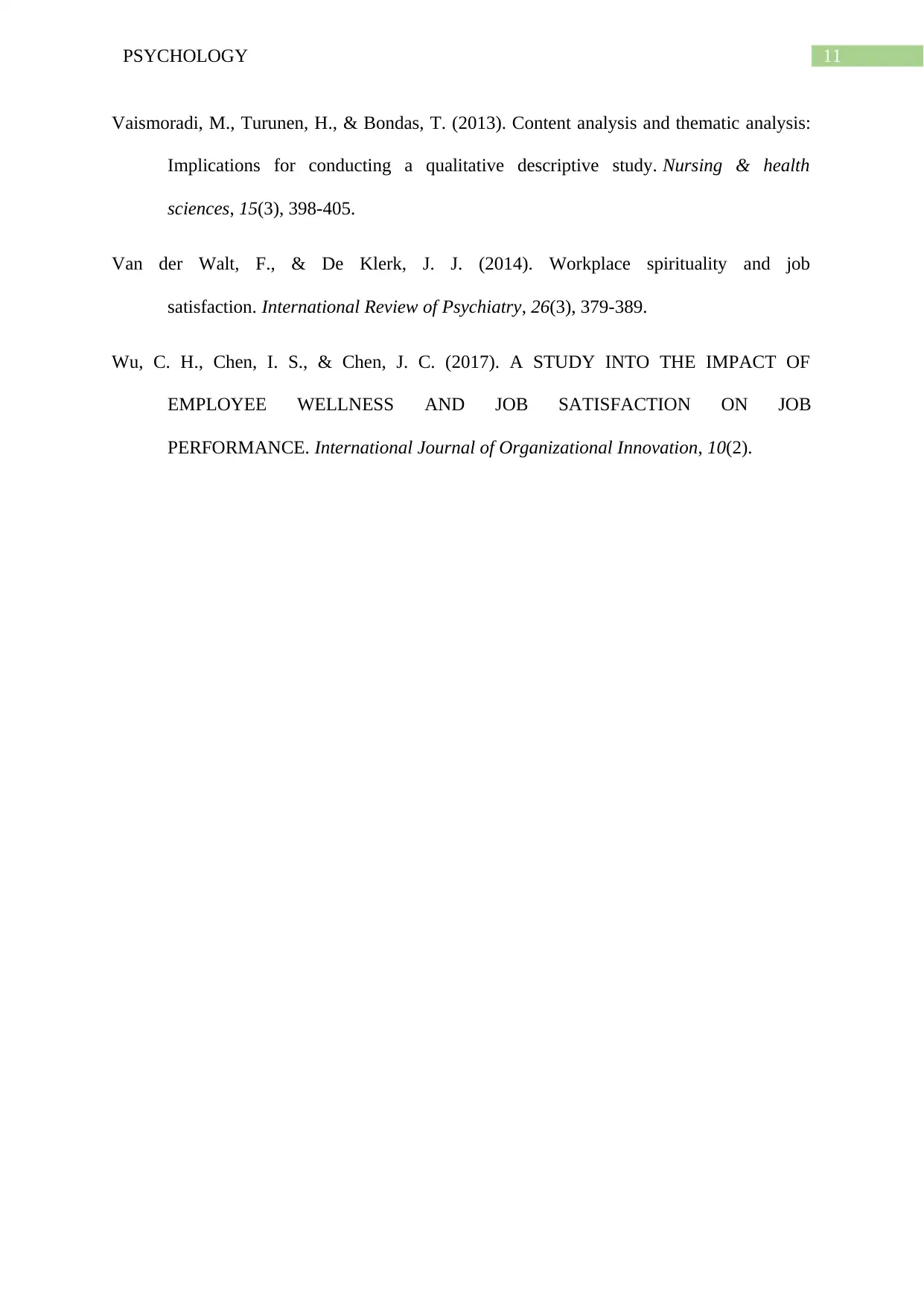
11PSYCHOLOGY
Vaismoradi, M., Turunen, H., & Bondas, T. (2013). Content analysis and thematic analysis:
Implications for conducting a qualitative descriptive study. Nursing & health
sciences, 15(3), 398-405.
Van der Walt, F., & De Klerk, J. J. (2014). Workplace spirituality and job
satisfaction. International Review of Psychiatry, 26(3), 379-389.
Wu, C. H., Chen, I. S., & Chen, J. C. (2017). A STUDY INTO THE IMPACT OF
EMPLOYEE WELLNESS AND JOB SATISFACTION ON JOB
PERFORMANCE. International Journal of Organizational Innovation, 10(2).
Vaismoradi, M., Turunen, H., & Bondas, T. (2013). Content analysis and thematic analysis:
Implications for conducting a qualitative descriptive study. Nursing & health
sciences, 15(3), 398-405.
Van der Walt, F., & De Klerk, J. J. (2014). Workplace spirituality and job
satisfaction. International Review of Psychiatry, 26(3), 379-389.
Wu, C. H., Chen, I. S., & Chen, J. C. (2017). A STUDY INTO THE IMPACT OF
EMPLOYEE WELLNESS AND JOB SATISFACTION ON JOB
PERFORMANCE. International Journal of Organizational Innovation, 10(2).
⊘ This is a preview!⊘
Do you want full access?
Subscribe today to unlock all pages.

Trusted by 1+ million students worldwide
1 out of 15
Related Documents
Your All-in-One AI-Powered Toolkit for Academic Success.
+13062052269
info@desklib.com
Available 24*7 on WhatsApp / Email
![[object Object]](/_next/static/media/star-bottom.7253800d.svg)
Unlock your academic potential
Copyright © 2020–2025 A2Z Services. All Rights Reserved. Developed and managed by ZUCOL.





